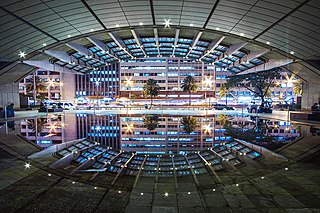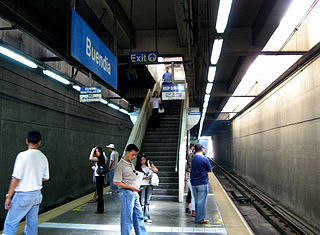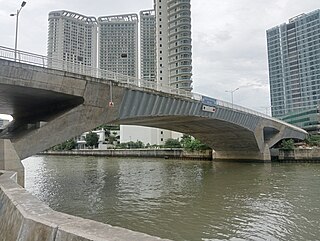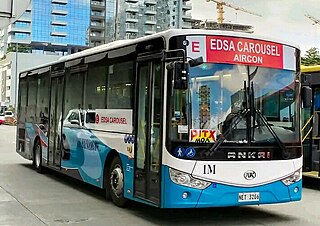
Transportation in the Philippines covers the transportation methods within this archipelagic nation of over 7,500 islands. From a previously underdeveloped state of transportation, the government of the Philippines has been improving transportation through various direct infrastructure projects, and these include an increase in air, sea, road, and rail transportation and transport hubs.

Metropolitan Manila, commonly shortened to Metro Manila and formally the National Capital Region, is the capital region and largest metropolitan area of the Philippines. Located on the eastern shore of Manila Bay, the region lies between the Central Luzon and Calabarzon regions. Encompassing an area of 619.57 km2 (239.22 sq mi) and with a population of 13,484,462 as of 2020, it is composed of sixteen highly urbanized cities: the capital city, Manila, Caloocan, Las Piñas, Makati, Malabon, Mandaluyong, Marikina, Muntinlupa, Navotas, Parañaque, Pasay, Pasig, Quezon City, San Juan, Taguig, and Valenzuela, along with one independent municipality, Pateros. As the second most populous and the most densely populated region in the Philippines, it ranks as the 9th most populous metropolitan area in Asia and the 6th most populous urban area in the world.

Makati, officially the City of Makati, is a highly urbanized city in the National Capital Region of the Philippines, known for being one of the leading financial center in the country. As of 2013, the city has the highest concentration of multinational and local corporations in the Philippines. Major banks, corporations, department stores as well as foreign embassies are based in Makati. Makati is also known for being a major cultural and entertainment hub in Metro Manila. According to the 2020 census, it had a population of 629,616 people, making it as the 47th most populous city in the country and ranked as the 43rd most densely populated city in the world with 19,336 inhabitants per square kilometer or 50,080 inhabitants per square mile. In 2023, the 10 Embo barangays were removed from Makati's jurisdiction as a result of the Makati–Taguig boundary dispute ruling, resulting in a reduction of the city's population to about 292,743. The daytime population of the city is estimated to be more than three million during a typical working day because of the large number of people who go to the city to work, shop, and do business.

The Pasig River is a water body in the Philippines that connects Laguna de Bay to Manila Bay. Stretching for 25.2 kilometers (15.7 mi), it bisects the Philippine capital of Manila and its surrounding urban area into northern and southern halves. Its major tributaries are the Marikina River and San Juan River. The total drainage basin of the Pasig River, including the basin of Laguna de Bay, covers 4,678 square kilometers (1,806 sq mi).

Epifanio de los Santos Avenue, commonly referred to by its acronym EDSA, is a limited-access circumferential highway around Manila, the capital city of the Philippines. It passes through 6 of Metro Manila's 17 local government units or cities, namely, from north to south, Caloocan, Quezon City, San Juan, Mandaluyong, Makati, and Pasay.

The Metropolitan Manila Development Authority is a government agency of the Philippines responsible for constituting the regional government of Metro Manila, comprising the capital city of Manila, the cities of Quezon City, Caloocan, Pasay, Mandaluyong, Makati, Pasig, Marikina, Muntinlupa, Las Piñas, Parañaque, Valenzuela, Malabon, Taguig, Navotas and San Juan, and the municipality of Pateros.

EDSA station is an elevated Light Rail Transit (LRT) station located on the LRT Line 1 (LRT-1) system in Pasay. The station is situated on the intersection of Taft Avenue and Epifanio de los Santos Avenue, better known as EDSA, one of Metro Manila's major thoroughfares. The station was named after EDSA, which in turn is named after Epifanio de los Santos, a noted historian.

Guadalupe station is an elevated Metro Rail Transit (MRT) station located on the MRT Line 3 (MRT-3) system in Makati. It is named because of its location between the barangays of Guadalupe Nuevo and Guadalupe Viejo, both are in turn named after Our Lady of Guadalupe.

Buendia station is an underground Metro Rail Transit (MRT) station located on the MRT Line 3 (MRT-3) system in Makati. It is one of two underground stations that can be found on the line, the other being Ayala. The station lies near the EDSA–Kalayaan Flyover and Gil Puyat Avenue in Makati.

The transportation system in Metro Manila covers the road network, rail network, ferries, ports and airports located with the metropolitan Manila area. Road transportation in Metro Manila is diverse, composed of many types of private and public transport vehicles. These include taxis, buses, jeepneys, tricycles and pedicabs. In some areas, especially in Divisoria and large public markets, two-stroke motors are fitted in the pedicabs and are used for goods transport. Regardless of modernity, horse-drawn kalesas are still used in the streets of Binondo and Intramuros. Ridesharing services such as Grab also operate within in Metro Manila.

The Magallanes Interchange is a four-level partial turbine interchange in Makati, Metro Manila, Philippines, serving as the junction between the Osmeña Highway, Epifanio de los Santos Avenue (EDSA), and South Luzon Expressway (SLEX). It is also an interchange between the two train lines of Metro Manila, the MRT-3, which is over EDSA, and the PNR Metro Commuter Line beside Osmeña Highway and SLEX. It is currently one of the busiest intersections in Metro Manila.

The Marcos Bridge is a road bridge that connects the Barangays of Calumpang and Barangka in Marikina in Metro Manila, Philippines

The Estrella–Pantaleon Bridge, also known as the Rockwell Bridge, is a four-lane box girder bridge crossing the Pasig River in Metro Manila, Philippines. It connects Estrella Street in Makati on the south bank of the Pasig River, to Pantaleon Street via Barangka Drive in Mandaluyong on the north bank, near the site of the Acqua Private Residences.

The Estrella Flyover, also known as the EDSA–Estrella Ramp and the Rockwell Flyover, is a two-lane flyover connecting Epifanio de los Santos Avenue (EDSA) and Estrella Street in Makati, Metro Manila, the Philippines, facilitating access to the Rockwell Center mixed-use development. It runs along the barangay boundary of Bel-Air with Pinagkaisahan and Guadalupe Viejo.

The Makati Park and Garden, sometimes called Fort Bonifacio Riverside Park and Liwasang Bonifacio by local residents, is an urban riverfront park along the south bank of the Pasig River in Taguig, Metro Manila, Philippines. It has an area of 35,433 square meters (381,400 sq ft). In the aftermath of the 2021 Supreme Court decision, which favors Taguig with regards to the political and territorial jurisdiction of Fort Bonifacio and the Embo barangays, ownership dispute arises when Taguig attempted to takeover the park on March 1, 2024. The City of Taguig claims the Park and Garden on the grounds of "(Makati's) unlawful possession".
The Metro Manila Subway, formerly known as the Mega Manila Subway (MMS), is an under-construction underground rapid transit line in Metro Manila, Philippines. The 33-kilometer (21 mi) line, which will run north–south between Valenzuela, Quezon City, Pasig, Taguig, Parañaque and Pasay, consists of 17 stations between the East Valenzuela and Bicutan stations. It will become the country's second direct airport rail link after the North–South Commuter Railway, with a branch line to Ninoy Aquino International Airport.

The EDSA Carousel, also known as Route 1 and formerly and still referred to as Route E, is a bus rapid transit (BRT) system, part of several bus routes in Metro Manila. It is situated along EDSA and other roads, running on a dedicated right-of-way called the EDSA Busway, separated from normal road traffic in most of its stretch by concrete barriers and steel bollards on the innermost lane.

The Makati–Mandaluyong Bridge is a four-lane road bridge crossing the Pasig River in Metro Manila, the Philippines. It connects P. Burgos Extension, a continuation of Makati Avenue in Barangay Poblacion, Makati at the south bank of the river to Coronado Street in Barangay Hulo, Mandaluyong at the north bank. The bridge was opened in 1986.

One Ayala, also known as One Ayala Avenue, is an under construction mixed-use development developed by Ayala Land located at Ayala Center in Makati, Metro Manila, Philippines. The development is located across Glorietta mall and occupies the former InterContinental Manila and EDSA Carpark sites. One Ayala aims to combine retail, hotel, and office facilities in a single contiguous space. Construction began in 2016 with the demolition of InterContinental Manila and EDSA Carpark and parts of the development opened in 2022.



















